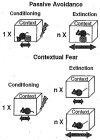Molecular specificity of multiple hippocampal processes governing fear extinction
- PMID: 20458884
- PMCID: PMC2922903
- DOI: 10.1515/revneuro.2010.21.1.1
Molecular specificity of multiple hippocampal processes governing fear extinction
Abstract
Over many years, fear extinction has been conceptualized as one dominant process, new inhibitory learning, which serves to dampen previously acquired fear. Here we present an alternative view, that brain region-specific processing of representations, expectations and emotional attributes of the fear-provoking event, recruits unique mechanisms that interdependently contribute to the conditioning and extinction of fear. The co-occurrence of these mechanisms within the fear circuit can thus be tracked and differentiated at a molecular and cellular level. Among others, the transcriptional regulators cFos, cAMP-dependent response element binding protein (CREB), Zif268, and extracellular signal-regulated kinases (Erk) stand out as hippocampal nuclear markers signaling novelty, arousal, retrieval, and prediction error, respectively. Consistent with evidence from human studies, these findings indicate that, beyond inhibitory learning, fear extinction requires modification of the emotional attributes and expectations that define the threatening context. Given the likely dysregulation of one or more of these processes in anxiety disorders, a key research challenge for the future is the identification and enhancement of individual extinction mechanisms to target the specific components of fear. Environmental stimuli lacking affective properties (conditioned stimuli, CS) rapidly become threatening if presented with stressful events (unconditioned stimuli, US). Consequently, based on a CS-US association, the presentation of the CS triggers species-specific fear responses until the US consistently stops occurring. At that point, new learning takes place and the fear response declines, a phenomenon termed extinction. The view that extinction occurs because a new, inhibitory CS-noUS association gains control over behavior, has remained dominant in the field. The implications of impaired fear regulation in the development of anxiety disorders have stimulated intense research in this area. Rodent studies identified the circuits involved in the conditioning and extinction of fear of salient cues, generating data that were confirmed in humans with brain imaging approaches. Nevertheless, research with experimental animals has not fully taken advantage of human data in order to better interpret extinction mechanisms in the framework of learning, expectation and emotion governing fear-motivated behavior. The present article aims to summarize recent molecular evidence on fear extinction, focusing on hippocampal mechanisms and experimental models of contextual fear, and compare the results with other relevant fear paradigms and human imaging studies. Instead of conceptualizing extinction learning as one process, such as CS-noUS association or inhibitory learning, we propose that fear extinction reflects the behavioral output of several region-specific learning processes that modify different components of the conditioning memory. The significance of these findings is discussed in the framework of fear regulation and anxiety disorders.
Figures





Similar articles
-
Learning pain-related fear: neural mechanisms mediating rapid differential conditioning, extinction and reinstatement processes in human visceral pain.Neurobiol Learn Mem. 2014 Dec;116:36-45. doi: 10.1016/j.nlm.2014.08.003. Epub 2014 Aug 13. Neurobiol Learn Mem. 2014. PMID: 25128878
-
Hippocampal Mek/Erk signaling mediates extinction of contextual freezing behavior.Neurobiol Learn Mem. 2007 Jan;87(1):149-58. doi: 10.1016/j.nlm.2006.08.003. Epub 2006 Sep 18. Neurobiol Learn Mem. 2007. PMID: 16979915 Free PMC article.
-
When gut feelings teach the brain to fear pain: Context-dependent activation of the central fear network in a novel interoceptive conditioning paradigm.Neuroimage. 2021 Sep;238:118229. doi: 10.1016/j.neuroimage.2021.118229. Epub 2021 Jun 1. Neuroimage. 2021. PMID: 34082119
-
Fear conditioning and extinction: emotional states encoded by distinct signaling pathways.Trends Neurosci. 2012 Mar;35(3):145-55. doi: 10.1016/j.tins.2011.10.003. Epub 2011 Nov 25. Trends Neurosci. 2012. PMID: 22118930 Free PMC article. Review.
-
The transition from memory retrieval to extinction.An Acad Bras Cienc. 2004 Sep;76(3):573-82. doi: 10.1590/s0001-37652004000300011. Epub 2004 Aug 23. An Acad Bras Cienc. 2004. PMID: 15334255 Review.
Cited by
-
White matter integrity in highly traumatized adults with and without post-traumatic stress disorder.Neuropsychopharmacology. 2012 Nov;37(12):2740-6. doi: 10.1038/npp.2012.146. Epub 2012 Aug 8. Neuropsychopharmacology. 2012. PMID: 22871912 Free PMC article.
-
Dynorphins regulate fear memory: from mice to men.J Neurosci. 2012 Jul 4;32(27):9335-43. doi: 10.1523/JNEUROSCI.1034-12.2012. J Neurosci. 2012. PMID: 22764240 Free PMC article.
-
N-Methyl D-aspartate receptor subunit signaling in fear extinction.Psychopharmacology (Berl). 2019 Jan;236(1):239-250. doi: 10.1007/s00213-018-5022-5. Epub 2018 Sep 20. Psychopharmacology (Berl). 2019. PMID: 30238131 Free PMC article. Review.
-
An Integrative Neuroscience Framework for the Treatment of Chronic Pain: From Cellular Alterations to Behavior.Front Integr Neurosci. 2018 May 23;12:18. doi: 10.3389/fnint.2018.00018. eCollection 2018. Front Integr Neurosci. 2018. PMID: 29875641 Free PMC article.
-
The effect of ketamine on the consolidation and extinction of contextual fear memory.J Psychopharmacol. 2018 Feb;32(2):156-162. doi: 10.1177/0269881117748903. Epub 2018 Jan 17. J Psychopharmacol. 2018. PMID: 29338491 Free PMC article.
References
-
- Abel T, Kandel E. Positive and negative regulatory mechanisms that mediate long-term memory storage. Brain Res Brain Res Rev. 1998;26:360–78. - PubMed
-
- Abrari K, Rashidy-Pour A, Semnanian S, Fathollahi Y. Administration of corticosterone after memory reactivation disrupts subsequent retrieval of a contextual conditioned fear memory: dependence upon training intensity. Neurobiol Learn Mem. 2008;89:178–184. - PubMed
-
- Aerni A, Traber R, Hock C, Roozendaal B, Schelling G, Papassotiropoulos A, Nitsch RM, Schnyder U, de Quervain DJ. Low-dose Cortisol for symptoms of posttraumatic stress disorder. Am J Psychiatry. 2004;161:1488–1490. - PubMed
-
- Ahi J, Radulovic J, Spiess J. The role of hippocampal signaling cascades in consolidation of fear memory. Behav Brain Res. 2004;149:17–31. - PubMed
Publication types
MeSH terms
Grants and funding
LinkOut - more resources
Full Text Sources
Miscellaneous
